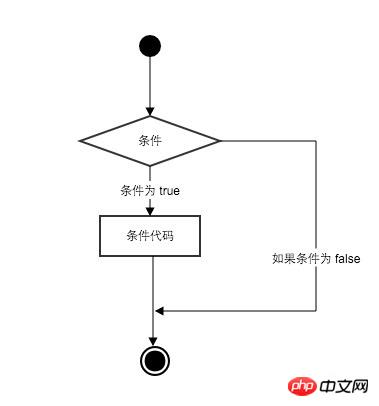Home >Backend Development >Python Tutorial >How to write conditional statements in python 01: single and multiple conditional judgments
Python is a high-level scripting language that combines interpretation, compilation, interactive and object-oriented scripting. Python is designed to be highly readable. Compared with other languages, it often uses English keywords and some punctuation marks in other languages. It has a more distinctive grammatical structure than other languages. The conditional statement in Python determines the executed code block based on the execution result (True or False) of one or more statements. How to write conditional statements in python? Beginners who have just come into contact with python can understand the execution process of conditional statements through the following Figure (1.1) :
 (Figure 1.1)
(Figure 1.1)
(The Python programming language specifies that any non-0 and non-null value is true , 0 or null is false.)
The if statement in Python programming is used to control the execution of the program, the basic form is as follows :
if 判断条件:
执行语句……
else:
执行语句……When the "judgment condition" is established (non-zero), the following statement will be executed, and the execution content Multiple lines are allowed, and indentation is used to distinguish the same range. else is an optional statement. When you need to execute the content when the condition is not true, you can execute the relevant statement.
How to write conditional statements in pythonSpecific examples are as follows:
#!/usr/bin/python
# -*- coding: UTF-8 -*-
flag = False
name = 'luren'
if name == 'python': # 判断变量否为'python'
flag = True # 条件成立时设置标志为真
print 'welcome boss' # 并输出欢迎信息
else:
print name # 条件不成立时输出变量名称The above examples The output result is as follows:
luren #输出结果
And when it is necessary to judge not just one but multiple values, the following form can be used:
if 判断条件1:
执行语句1……
elif 判断条件2:
执行语句2……
elif 判断条件3:
执行语句3……
else:
执行语句4……Next let me give an example:
#!/usr/bin/python
# -*- coding: UTF-8 -*-
num = 5
if num == 3: # 判断num的值
print 'boss'
elif num == 2:
print 'user'
elif num == 1:
print 'worker'
elif num < 0: # 值小于零时输出
print 'error'
else:
print 'roadman' # 条件均不成立时输出The value output by this example is as follows:
roadman #输出结果
(Due to python It does not support switch statements, so multiple conditional judgments can only be implemented using elif)
The above example can be understood as when the variable you output will output "boss", If the first condition is not met, the second condition will be entered for judgment. By analogy, when all conditions are not met, "roadman" will be output.
Today’s article is about two situations: single condition and multiple conditions in python conditional statements. I hope you can gain something from the explanation of the above code. In addition to these two situations, there are other situations in conditional statements. As for those other situations, I will explain them in the next article.
【Related recommendations】
How to write conditional statements in python 02: Simultaneous judgment and simple statement groups
The above is the detailed content of How to write conditional statements in python 01: single and multiple conditional judgments. For more information, please follow other related articles on the PHP Chinese website!